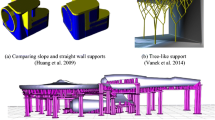Abstract
In this paper, we propose a new joint-based assembly modeling method. In joint-based assembly modeling, the assembly constraints are specified on the components, but not on the geometric elements of the components. The proposed method generates assembly models from kinematic joint constraints by applying three procedures (1) to extract all feasible JMFs (Joint Mating Feature) for each mating component using information on joint constraints, (2) to derive mating alternatives for each pair of mating components after reducing the number of JMFs using the pruning criteria, and (3) to generate an assembly model by choosing the intended one from the mating alternatives for each pair of mating components and solving the JMF constraints. Since the joint constraints are expressed in terms of the relations between components rather than relations between geometric elements, the proposed method is more intuitive and natural for assembly modeling and supports modeling activities effectively by minimizing user interactions. By using joint mating constraints for assembly modeling, moreover, the kinematic behaviors of assemblies determined in the conceptual design stage can be directly applied and consistently maintained up to the detailed design stage. In the proposed method, it is also not necessary to re-input the mating constraints even when the component topology is changed.
Similar content being viewed by others
References
Bedworth D, Henderson M, Wolfe P (1991) Computer-integrated design and manufacturing. McGraw-Hill, New York
Noort A, Hoek G, Bronsvoort W (2002) Integrating part and assembly modeling. Comput Aided Des ign 34(12):899–912
Kim J, Kim K, Lee J, Choi K (2000) Solving 3D geometric constraints for assembly modeling. Int J Adv Manuf Technol 16(11):843–849
Holland W (1998) Assembly features in modeling and planning. PhD thesis, Delft University of Technology
SolidWorks Corporation (2002) SolidWorks user’s manual
Kramer GA (1992) Solving geometric constraint system: a case study in kinematics. MIT Press, Cambridge
Oliver JH, Harangozo MJ (1992) Inference of link positions for planar closed-loop mechanisms. Comput Aided Des 24(1):18–26
Whitney D, Mantripragada R, Adams J, Rhee S (1999) Designing assemblies. Res Eng Des 11(4):229–253
MSC Software (2002) Working model user’s manual
Craig J (1989) Introduction to robotics. Addison-Wesley, Boston
Nnaji B, Liu H (1990) Feature reasoning for automatic robotic assembly and machining in polyhedral representation. Int J Prod Res 28(3):517–540
Kim J, Kim K, Lee J, Jung H (2004) Solving 3D geometric constraints for closed-loop assemblies. Int J Adv Manuf Technol 23(9):755–761
Author information
Authors and Affiliations
Corresponding author
Rights and permissions
About this article
Cite this article
Kim, J., Kim, K., Lee, J. et al. Generation of assembly models from kinematic constraints. Int J Adv Manuf Technol 26, 131–137 (2005). https://doi.org/10.1007/s00170-004-2231-3
Received:
Accepted:
Published:
Issue Date:
DOI: https://doi.org/10.1007/s00170-004-2231-3




